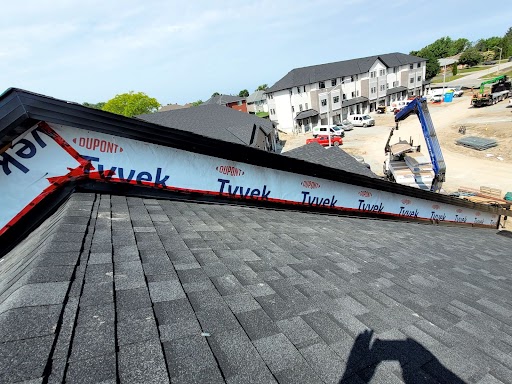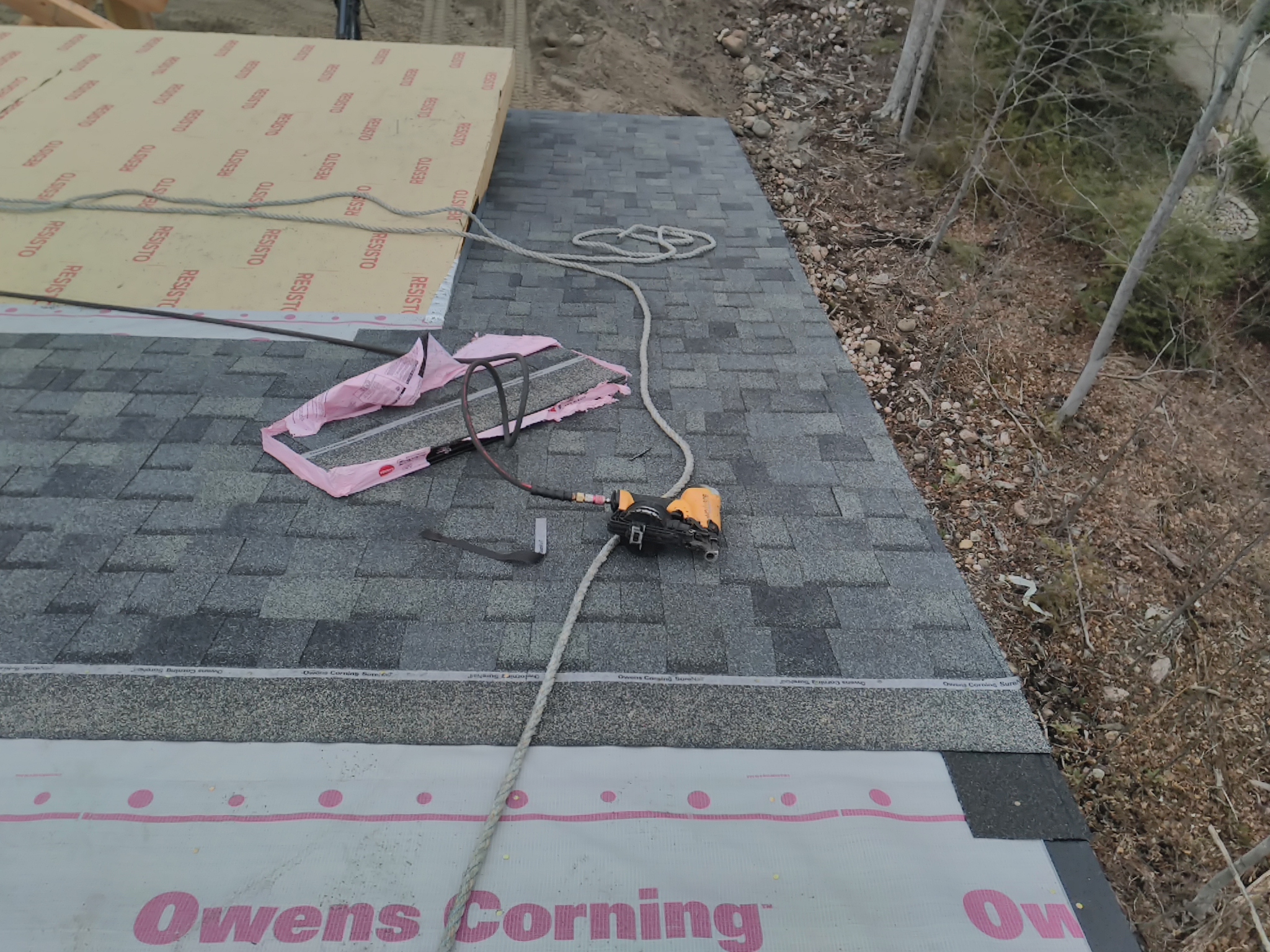Introduction
Hailstorms can be a homeowner’s nightmare, leaving behind a trail of damage, especially on roofs. Identifying and repairing hail damage promptly is crucial to prevent further issues. In this article, Ainger Roofing, a Newmarket roofing company will guide you through the process of spotting and repairing roof hail damage to keep your home safe and secure.

Identifying Roof Hail Damage
Signs of Hail Damage on Shingles
Hail damage on shingles can appear as dents, cracks, or missing granules. Look for circular or irregular marks, bruising, or areas where the shingle has been punctured.
Damage to Metal Roofing
Metal roofs may show signs of hail damage through dents or dings. Although they might not immediately cause leaks, these imperfections can lead to long-term issues like rust.
Inspecting Gutters and Downspouts
Check your gutters and downspouts for dents and the presence of granules. An accumulation of granules in your gutters is a sign that your shingles are deteriorating.
Checking for Leaks and Water Damage
Inspect your attic and ceilings for water stains or leaks. Water intrusion can indicate roof damage that needs immediate attention.
Tools Needed for Inspection and Repair
Safety Gear
Wear appropriate safety gear, including gloves, safety glasses, and non-slip shoes, to protect yourself during inspection and repair.
Inspection Tools
Equip yourself with a sturdy ladder, flashlight, binoculars, and a chalk or marker to identify and document damage.
Repair Materials
Depending on the type of roof, you may need replacement shingles, roofing nails, sealant, metal patch kits, or tile adhesive.
Detailed Inspection Process
Safety First: Precautions to Take
Before climbing onto your roof, ensure the ladder is stable and the weather conditions are safe. Always work with a partner for added safety. It is best to hire a Newmarket roofing company.
Inspecting from the Ground
Use binoculars to inspect the roof from the ground. Look for obvious signs of damage, such as dents or missing shingles.
Conducting a Roof Walk-Through
Carefully walk the roof, checking each section for damage. Pay close attention to valleys, vents, and edges where damage is more likely to occur.
Documenting Damage
Take photos and notes of any damage you find. This documentation will be useful when filing insurance claims or planning repairs.
Types of Hail Damage
Cosmetic vs. Functional Damage
Cosmetic damage affects the roof’s appearance but not its functionality, while functional damage can lead to leaks and structural issues.
Common Damage Patterns on Different Roofing Materials
- Asphalt Shingles: Bruises, missing granules, cracks
- Metal Roofs: Dents, dings, chipped paint
- Tile Roofs: Cracked or broken tiles
DIY vs. Professional Inspection
When to DIY
You can handle minor inspections and repairs yourself if you feel comfortable and have the necessary tools.
When to Call a Professional Newmarket Roofing Company
For extensive damage, or if you’re unsure about the extent of the damage, it’s best to hire a professional roofer to conduct a thorough inspection and make repairs.
Repairing Hail Damage
Temporary Fixes
Use tarps or roofing cement to cover damaged areas temporarily, preventing water from entering your home until permanent repairs can be made.
Permanent Repair Methods
- Repairing Shingles: Replace damaged shingles by removing the old ones and nailing new ones in place. Apply sealant to ensure they are secure.
- Repairing Metal Roofs: Use a metal patch kit to cover dents and dings. Ensure the patch matches the roof colour and material.
- Repairing Tile Roofs: Replace cracked or broken tiles with new ones, using tile adhesive to secure them.
Preventive Measures
Installing Impact-Resistant Roofing Materials
Consider upgrading to impact-resistant shingles or metal roofing designed to withstand hailstorms.
Regular Maintenance and Inspections
Regularly inspect and maintain your roof to catch potential issues early and extend its lifespan.
Insurance and Hail Damage
Understanding Your Insurance Policy
Review your homeowner’s insurance policy to understand what types of roof damage are covered and the process for filing a claim.
Filing a Claim
Document the damage and contact your insurance company to file a claim. Provide all necessary documentation and follow their instructions.
Working with Insurance Adjusters
Cooperate with insurance adjusters during their inspection. Share your documentation and be present to answer questions.
Case Studies of Hail Damage and Repair
Example 1: Residential Roof
A homeowner noticed dents and granule loss after a hailstorm. A professional roofer replaced the damaged shingles, restoring the roof’s integrity.
Example 2: Commercial Building
A commercial building with a metal roof sustained multiple dents. Repairs involved patching the dents and repainting the roof to prevent rust.
Example 3: Historic Property
A historic property with tile roofing had several broken tiles after a hailstorm. Specialized contractors replaced the tiles with matching ones to maintain the property’s appearance and function.
Future Trends in Roofing and Hail Protection
Advances in Roofing Materials
New materials are being developed that offer better hail resistance and durability, providing longer-lasting protection for roofs.
Technology in Damage Detection
Innovative technologies, such as drones and thermal imaging, are being used to detect and assess roof damage more accurately.
Conclusion
Spotting and repairing hail damage on your roof is essential to maintaining your home’s safety and value. By conducting regular inspections, a Newmarket roofing company says understanding the types of damage, and knowing when to call in professionals, you can ensure your roof remains in top condition.
FAQs
How often should I inspect my roof for hail damage?
Inspect your roof at least twice a year and after any major hailstorm to catch damage early and prevent further issues.
What size hail can cause significant roof damage?
Hailstones as small as 1 inch in diameter can cause significant damage to roofs, especially if the hail is driven by strong winds.
Can I prevent hail damage to my roof?
While you can’t prevent hail, you can minimize damage by using impact-resistant roofing materials and maintaining your roof regularly.
How long does it take to repair hail damage?
The time required for repairs depends on the extent of the damage and the type of roof. Minor repairs may take a few hours, while extensive damage could take several days.
Is hail damage covered by standard homeowner’s insurance?
Most homeowner’s insurance policies cover hail damage, but it’s essential to review your policy details and understand the coverage limits and deductibles.

